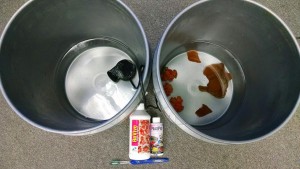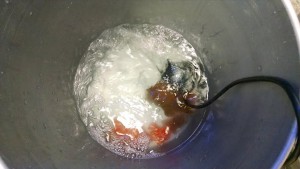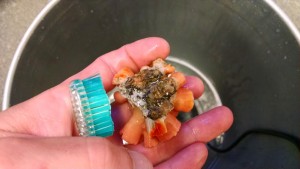 Hate is a strong word. A word that I rarely, if ever, use. But I hate coral predators! These pesky little bugs can ruin years of work, bring grown reefers to their knees in tears and cause thousands upon thousands of [polyp] lives and dollars lost. One way to help prevent coral pests is dipping, which can be done in so many ways it’s hard to wrap a new reefers mind around.
Hate is a strong word. A word that I rarely, if ever, use. But I hate coral predators! These pesky little bugs can ruin years of work, bring grown reefers to their knees in tears and cause thousands upon thousands of [polyp] lives and dollars lost. One way to help prevent coral pests is dipping, which can be done in so many ways it’s hard to wrap a new reefers mind around.
The basics are simple, and should be followed by all reefers in my opinion:
- Choose your weapon (read: dip). There are many on the market today, some wielding wild claims that come up empty handed, so be wary and read reviews. As of this posting not one dip on the market kills eggs of pests [without killing the coral too]. Eggs must be inspected for visually, and better yet, new additions should be quarantined for a period of time prior to being introduced into your display aquarium. A few common dips that come to mind are: ReVive, Bayer insecticide, RPS All-Out and Coral Rx. Please be sure to follow the directions of manufacturer, and read reviews of any aforementioned product prior to using.
- Prepare your dip and rinse water. Personally I use a five gallon bucket, but any reservoir can work. Make sure to have a powerhead or something to stir the water within the dip reservoir, which helps remove pests.
- Place coral in dip and set timer so you don’t forget (most dips call for a fifteen minute period). Turn on powerhead or stir vigorously every few minutes. Some dips don’t kill pests, rather they’ll stun the pests which can then be knocked off via high flow. Error on the shorter side of a dip if you’re treating many corals at once to ensure you don’t go over allotted time.
- Remove coral from dip and scrub base and skeleton purposefully to remove any pests and their eggs. A toothbrush works great for this. Most coral predators lay their eggs around the base of the coral, rather than the tissue itself. Some people even go the next step and remove the plug/rock entirely from the bottom of the coral. Even so you should still scrub the base of the coral, or any dead skeleton visible as a precautionary measure. This also helps prevent unwanted algaes from making their way into your aquarium.
- Place coral in rinse water. Swish coral around briefly, then let sit for ten to fifteen minutes. Some dips require longer or more involved rinsing due to their ingredients, so be sure you know what you’re dealing with.
- Ideally this is when you place a coral in a quarantine system. Even though you’ve likely knocked off all the adults and scrubbed away the majority of eggs, if one egg makes its way through this is all for naught. Quarantined corals can be inspected every few days for the presence of predators and treated as necessary. After a month in quarantine I’m confident to place healthy corals in my display aquarium.
- Place corals in your display, and grow the crap out of them!















0 Comments